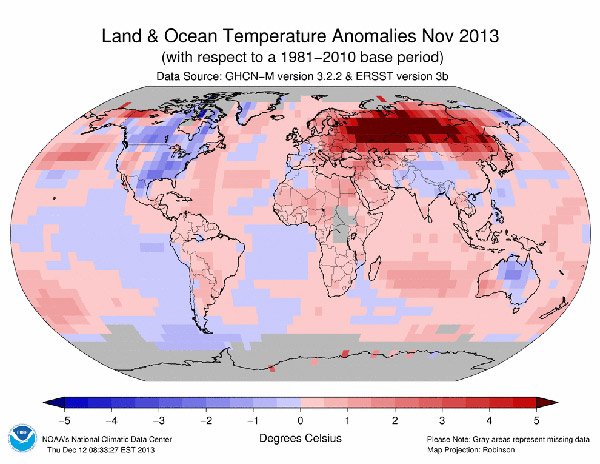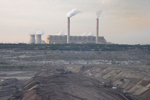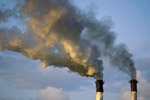Last month was the warmest November on record, according to new analysis from the NOAA. Temperatures were 0.78 degrees Celsius (1.40 degrees Fahrenheit) above the average November in the 20th Century. Global temperatures are on the rise due to climate change caused primarily by burning fossil fuels, but also by deforestation and land-use change.
While parts of the US and Canada saw temperatures well below average for November, Russia was roasting, at least compared to average temperatures. Parts of Russia saw temperatures that were 8 degrees Celsius (14 degrees Fahrenheit) above average for the month. More astoundingly, November was the 345th month in a row that has been warmer than the 20th Century average.
Through November, 2013 is shaping up to tie for the fourth warmest year on record. However, recent research has challenged current temperature records as underplaying the rate of global warming due to data gaps in the Arctic. The Arctic is warming faster than anywhere else on the plant, and leaving out data here has likely underestimated the rate of warming.
The most recent report by the Intergovernmental Panel on Climate Change (IPCC) has released its first global carbon budget, which outlines how much carbon can be burnt before we cross the line into catastrophic climate change. According to the budget, the vast majority of the world’s remaining fossil fuel reserves will have to be left untouched.

November 2013 temperature anomaly as compared to 1981-2010. Map courtesy of NOAA.
Related articles
Top scientists propose ambitious plans to safeguard world from devastating climate change

(12/05/2013) Two degrees is too much: that’s the conclusion of a landmark new paper by top economists and climatologists, including James Hansen formerly of NASA. The paper, appearing in the open-access journal PLoS ONE, argues that global society must aim for only one degree Celsius of warming above pre-industrial levels to avoid the worst impact of climate change, and not the two degrees Celsius agreed on by the world’s governments. But given that the world’s governments are not yet on track to even achieve the two degree target, how could we lock in just one? A combination of renewable energy, nuclear power, and, most importantly, a rising price on carbon emissions, according to the eighteen scientists.
Satellites reveal browning mountain forests

(11/22/2013) In a dramatic response to global warming, tropical forests in the high elevation areas of five continents have been “browning” since the 1990s. They have been steadily losing foliage, and showing less photosynthetic activity. Scientists analyzed the forest cover by using satellites to measure sunlight bouncing off the surface of the earth, then determining the different surface types via reflection patterns.
The emissions gap and the forest contribution (commentary)

(11/20/2013) Shortly before the Warsaw climate talks, the United Nations Environmental Programme (UNEP) released its Emissions Gap report, highlighting the growing gap between the emissions reductions that are needed to stay below 2 degrees and the trajectory the world is on at the moment. The report clearly identifies forests as one of the most important options to reduce emissions which can be delivered in the short term. While parties urgently need to start phasing out fossil fuels and stop emissions from fossil fuels no later than 2050, protecting forests now can help significantly to keep a realistic chance of staying below 2 degrees.
UN talks tough to global coal industry

(11/19/2013) Yesterday, at the International Coal and Climate Summit—just a couple miles from the ongoing UN Climate Summit—Christiana Figueres delivered a speech unlike anything ever heard at a coal industry meeting before. Figueres, the Executive Director of the UN Framework Convention on Climate Change (UNFCCC), took time off from wrangling world leaders and officials toward a climate agreement to talk tough to an industry currently worth around $3 trillion.
Carbon emissions set to hit new record high in 2013

(11/19/2013) The amount of carbon dioxide emitted into the atmosphere in 2013 is expected to hit a new high of 36 billion tonnes, according to a Carbon Budget released today by the Global Carbon Project (GCP). This is a 2.1 percent rise from 2012 based on data from the same group. ‘We have exhausted about 70 per cent of the cumulative emissions that keep global climate change likely below two degrees,’ said GCP member, Pierre Friedlingstein, with the University of Exeter. ‘In terms of CO2 emissions, we are following the highest climate change scenario of the Intergovernmental Panel on Climate Change released in September.’
World’s most vulnerable nation to climate change turns to coal power

(11/18/2013) In October, a global risks analysis company, Maplecroft, named Bangladesh the world’s most vulnerable nation to climate change by 2050. The designation came as little surprise, since Bangladesh’s government and experts have been warning for years of climatic impacts, including rising sea levels, extreme weather, and millions of refugees. However, despite these very public warnings, in recent years the same government has made a sudden turn toward coal power—the most carbon intensive fuel source—with a master plan of installing 15,000 megawatts (MW) of coal energy by 2030, which could potentially increase the country’s current carbon dioxide emissions by 160 percent.